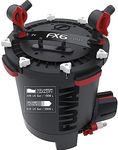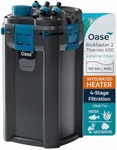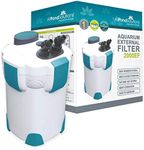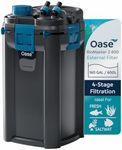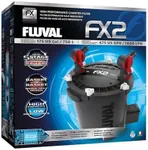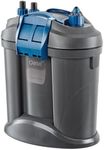Buying Guide for the Best Aquarium Filters
Choosing the right aquarium filter is crucial for maintaining a healthy and clean environment for your aquatic pets. The filter helps to remove debris, excess food, and harmful chemicals from the water, ensuring that your fish and plants thrive. When selecting an aquarium filter, it's important to consider several key specifications to ensure you pick the best fit for your specific needs.Filter TypeThere are several types of aquarium filters, including hang-on-back (HOB), canister, sponge, and internal filters. Each type has its own advantages and is suitable for different aquarium setups. HOB filters are easy to install and maintain, making them ideal for beginners. Canister filters offer superior filtration and are great for larger tanks. Sponge filters are perfect for small tanks and breeding setups, as they provide gentle filtration. Internal filters are compact and fit inside the tank, making them suitable for small to medium-sized aquariums. Choose a filter type based on the size of your tank, the type of aquatic life you have, and your maintenance preferences.
Flow RateThe flow rate of a filter, measured in gallons per hour (GPH), indicates how much water the filter can process in an hour. This is important because it determines how effectively the filter can clean the water. For optimal filtration, the flow rate should be at least four times the volume of your aquarium. For example, a 20-gallon tank would need a filter with a flow rate of at least 80 GPH. Higher flow rates are better for larger tanks or tanks with a high bioload, while lower flow rates are suitable for smaller tanks or delicate species that prefer gentle water movement.
Filtration StagesAquarium filters typically offer three stages of filtration: mechanical, chemical, and biological. Mechanical filtration removes physical debris from the water, chemical filtration removes dissolved impurities, and biological filtration promotes the growth of beneficial bacteria that break down harmful waste. A good filter should provide all three stages to ensure comprehensive water purification. When choosing a filter, consider one that offers multi-stage filtration to maintain a balanced and healthy aquarium environment.
Tank Size CompatibilityFilters are designed to handle specific tank sizes, so it's important to choose one that matches the size of your aquarium. Using a filter that is too small for your tank can lead to inadequate filtration, while an oversized filter can create too much water movement, stressing your fish. Check the manufacturer's recommendations for tank size compatibility and select a filter that is appropriate for your aquarium's volume.
Noise LevelThe noise level of a filter can affect the overall enjoyment of your aquarium. Some filters operate more quietly than others, which can be important if your aquarium is located in a living room, bedroom, or office. Look for filters that are specifically designed to operate quietly if noise is a concern for you. Reading user reviews and product descriptions can help you gauge the noise level of different filters.
Maintenance RequirementsDifferent filters have varying maintenance requirements, which can affect how easy they are to clean and maintain. Some filters have easily accessible parts that can be quickly cleaned or replaced, while others may require more effort. Consider how much time and effort you are willing to invest in maintaining your filter. If you prefer low-maintenance options, look for filters that are known for their ease of maintenance.
